Comparison of macrophage antimicrobial responses induced by type II interferons of the goldfish (Carassius auratus L.)
- PMID: 20507977
- PMCID: PMC2911290
- DOI: 10.1074/jbc.M109.096925
Comparison of macrophage antimicrobial responses induced by type II interferons of the goldfish (Carassius auratus L.)
Abstract
Unlike mammals, bony fish have two type II interferons, IFNgamma and IFNgammarel, whose pro-inflammatory functions have not been fully characterized. To elucidate the distinct roles of these type II interferons of bony fish, we examined the effects of recombinant goldfish (rg) IFNgamma and IFNgammarel on the macrophage antimicrobial responses, immune gene expression, and their signaling pathways. Our findings indicate that rgIFNgamma and rgIFNgammarel possess unique capacities to mediate each of the above processes. Q-PCR analysis revealed similar expression of both cytokines in tissues and immune cell populations of the goldfish, although IFNgamma mRNA levels were generally higher in most tissues and cell types. Whereas rgIFNgamma had long-lasting effects on the priming of goldfish monocyte ROI production, the rgIFNgammarel had relatively short-lived ROI priming potential and eventually down-regulated the priming of ROI production induced by rgIFNgamma or rgTNFalpha2. Whereas rgIFNgamma induced relatively modest phagocytic and nitric oxide responses of goldfish macrophages, rgIFNgammarel induced significantly higher phagocytosis, iNOSA and iNOSB gene expression and nitric oxide production compared with rgIFNgamma. The rgIFNgamma and rgIFNgammarel induced different gene expression profiles in goldfish monocytes. These differences included significantly higher induction of TNFalpha2, CXCL8, ceruloplasmin, and interferon regulatory factor (IRFs) expression after activation of monocytes with rgIFNgammarel. The rgIFNgammarel was more abundant in whole cell lysates compared with rgIFNgamma. Both cytokines induced the phosphorylation of Stat1, while the nuclear localization of Stat1 was only observed following treatment of monocytes with rgIFNgamma. Our findings suggest the presence of functional segregation of the induction of macrophage antimicrobial functions by type II interferons of bony fish.
Figures
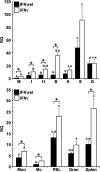
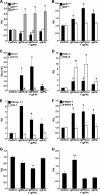
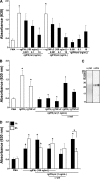
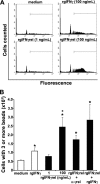
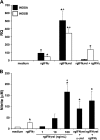

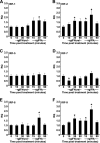
Similar articles
-
Analysis of the antimicrobial responses of primary phagocytes of the goldfish (Carassius auratus L.) against Mycobacterium marinum.Dev Comp Immunol. 2011 Nov;35(11):1146-58. doi: 10.1016/j.dci.2011.04.007. Epub 2011 Apr 21. Dev Comp Immunol. 2011. PMID: 21530582
-
Characterization and functional analysis of goldfish (Carassius auratus L.) interleukin-10.Mol Immunol. 2011 Jan;48(4):563-71. doi: 10.1016/j.molimm.2010.10.013. Epub 2010 Dec 10. Mol Immunol. 2011. PMID: 21111485
-
Macrophage colony-stimulating factor (CSF-1) induces pro-inflammatory gene expression and enhances antimicrobial responses of goldfish (Carassius auratus L.) macrophages.Fish Shellfish Immunol. 2009 Mar;26(3):406-13. doi: 10.1016/j.fsi.2008.12.001. Epub 2008 Dec 10. Fish Shellfish Immunol. 2009. PMID: 19130890
-
Goldfish (Carassius auratus L.) as a model system to study the growth factors, receptors and transcription factors that govern myelopoiesis in fish.Dev Comp Immunol. 2016 May;58:68-85. doi: 10.1016/j.dci.2015.10.024. Epub 2015 Nov 3. Dev Comp Immunol. 2016. PMID: 26546240 Review.
-
Antimicrobial responses of teleost phagocytes and innate immune evasion strategies of intracellular bacteria.Dev Comp Immunol. 2014 Apr;43(2):223-42. doi: 10.1016/j.dci.2013.08.003. Epub 2013 Aug 15. Dev Comp Immunol. 2014. PMID: 23954721 Review.
Cited by
-
A novel application of bubble-eye strain of Carassius auratus for ex vivo fish immunological studies.Sci Rep. 2021 May 24;11(1):10757. doi: 10.1038/s41598-021-89882-1. Sci Rep. 2021. PMID: 34031429 Free PMC article.
-
The Function of Fish Cytokines.Biology (Basel). 2016 May 24;5(2):23. doi: 10.3390/biology5020023. Biology (Basel). 2016. PMID: 27231948 Free PMC article. Review.
-
Mechanisms of amphibian macrophage development: characterization of the Xenopus laevis colony-stimulating factor-1 receptor.Int J Dev Biol. 2014;58(10-12):757-66. doi: 10.1387/ijdb.140271jr. Int J Dev Biol. 2014. PMID: 26154317 Free PMC article.
-
Oral administration of a new copper (I) complex with coumarin as ligand: modulation of the immune response and the composition of the intestinal microbiota in Onchorhynchus mykiss.Front Chem. 2024 May 14;12:1338614. doi: 10.3389/fchem.2024.1338614. eCollection 2024. Front Chem. 2024. PMID: 38807978 Free PMC article.
-
Zearalenone (ZEN) and Its Influence on Regulation of Gene Expression in Carp (Cyprinus carpio L.) Liver Tissue.Toxins (Basel). 2017 Sep 15;9(9):283. doi: 10.3390/toxins9090283. Toxins (Basel). 2017. PMID: 28914814 Free PMC article.
References
-
- Mosmann T. R., Coffman R. L. (1989) Annu. Rev. Immunol. 7, 145–173 - PubMed
-
- Sad S., Marcotte R., Mosmann T. R. (1995) Immunity 2, 271–279 - PubMed
-
- Perussia B. (1991) Curr. Opin. Immunol. 3, 49–55 - PubMed
-
- Wheelock E. F. (1965) Science 149, 310–311 - PubMed
-
- Staeheli P. (1990) Adv. Virus. Res. 38, 147–200 - PubMed
Publication types
MeSH terms
Substances
LinkOut - more resources
Full Text Sources
Research Materials
Miscellaneous

